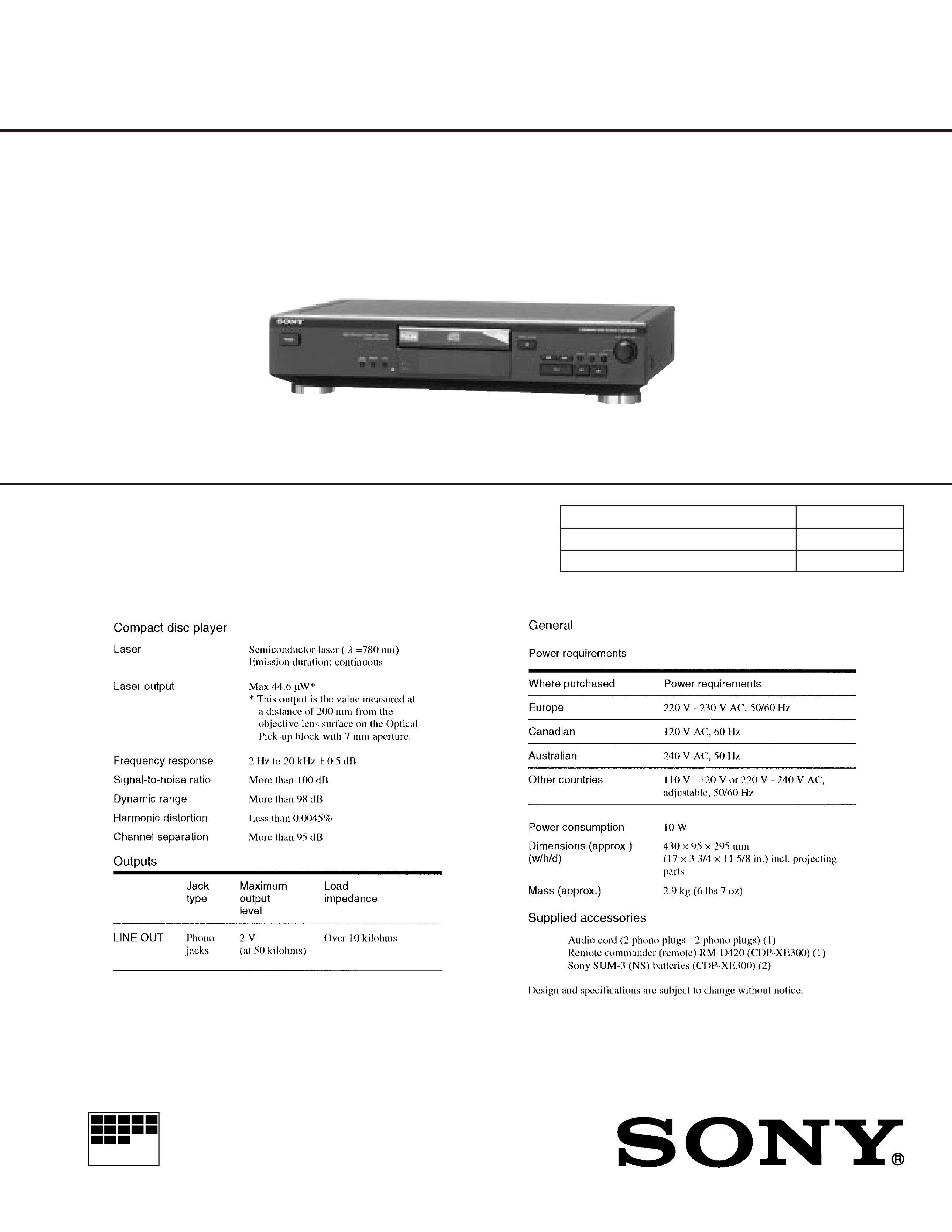
1
CDP-XE200/XE300
SERVICE MANUAL
Canadian Model
AEP Model
UK Model
Australian Model
CDP-XE200/XE300
E Model
Chinese Model
CDP-XE200
Photo: CDP-XE300
Model Name Using Similar Mechanism
CDP-XE500
CD Mechanism Type
CDM14-5BD20
Base Unit Name
BU-5BD20
SPECIFICATIONS
MICROFILM
COMPACT DISC PLAYER
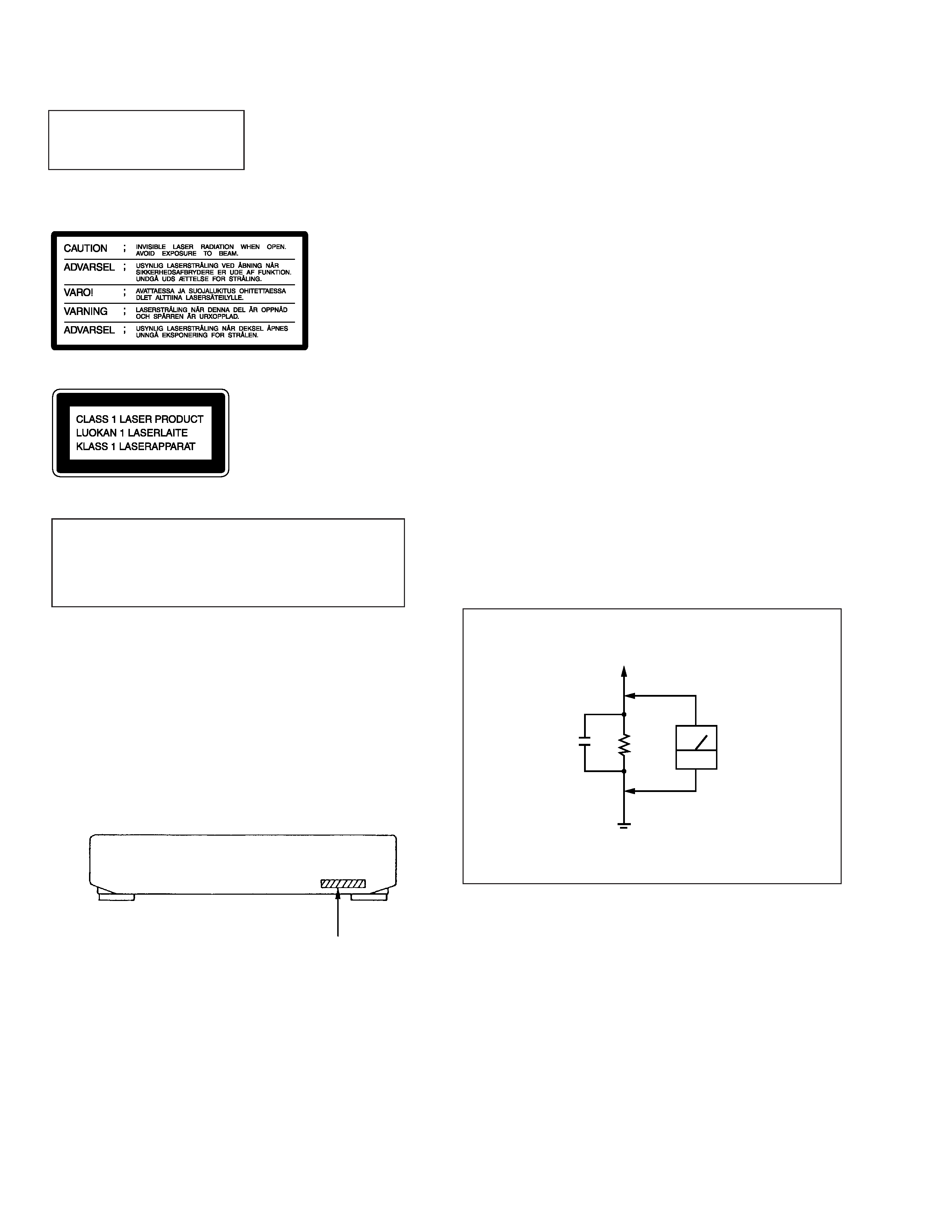
2
The laser component in this product
is capable of emitting radiation
exceeding the limit for Class 1.
The following caution label is located inside of the unit.
To Exposed Metal
Parts on Set
0.15µF
1.5k
AC
voltmeter
(0.75V)
Earth Ground
Fig. A. Using an AC voltmeter to check AC leakage.
SAFETY CHECK-OUT
After correcting the original service problem, perform the following
safety check before releasing the set to the customer:
Check the antenna terminals, metal trim, "metallized" knobs, screws,
and all other exposed metal parts for AC leakage. Check leakage as
described below.
LEAKAGE TEST
The AC leakage from any exposed metal part to earth ground and
from all exposed metal parts to any exposed metal part having a re-
turn to chassis, must not exceed 0.5 mA (500 microampers).
Leakage current can be measured by any one of three methods.
1. A commercial leakage tester, such as the Simpson 229 or RCA
WT-540A. Follow the manufacturers' instructions to use these
instruments.
2. A battery-operated AC milliammeter. The Data Precision 245 digi-
tal multimeter is suitable for this job.
3. Measuring the voltage drop across a resistor by means of a VOM
or battery-operated AC voltmeter. The "limit" indication is 0.75
V, so analog meters must have an accurate low-voltage scale. The
Simpson 250 and Sanwa SH-63Trd are examples of a passive VOM
that is suitable. Nearly all battery operated digital multimeters that
have a 2V AC range are suitable. (See Fig. A)
This appliance is classified
as a CLASS 1 LASER
product.
The CLASS 1 LASER
PRODUCT MARKING is
located on the rear exterior.
CAUTION
Use of controls or adjustments or performance of proce-
dures other than those specified herein may result in haz-
ardous radiation exposure.
Notes on Chip Component Replacement
· Never reuse a disconnected chip component.
· Notice that the minus side of a tantalum capacitor may be dam-
aged by heat.
MODEL IDENTIFICATION
Back Panel
CDP-XE200 :
Canadian Model
: 4-978-388-4
Australian Model
: 4-978-388-5
E Model
: 4-978-388-9
Chinese Model
: 4-979-971-0
UK Model
: 4-979-971-1
AEP, German, East European Model
: 4-979-971-2
CDP-XE300 :
AEP, German, East European Model
: 4-978-388-2
UK Model
: 4-978-388-3
Australian Model
: 4-978-388-6
Canadian Model
: 4-978-388-8
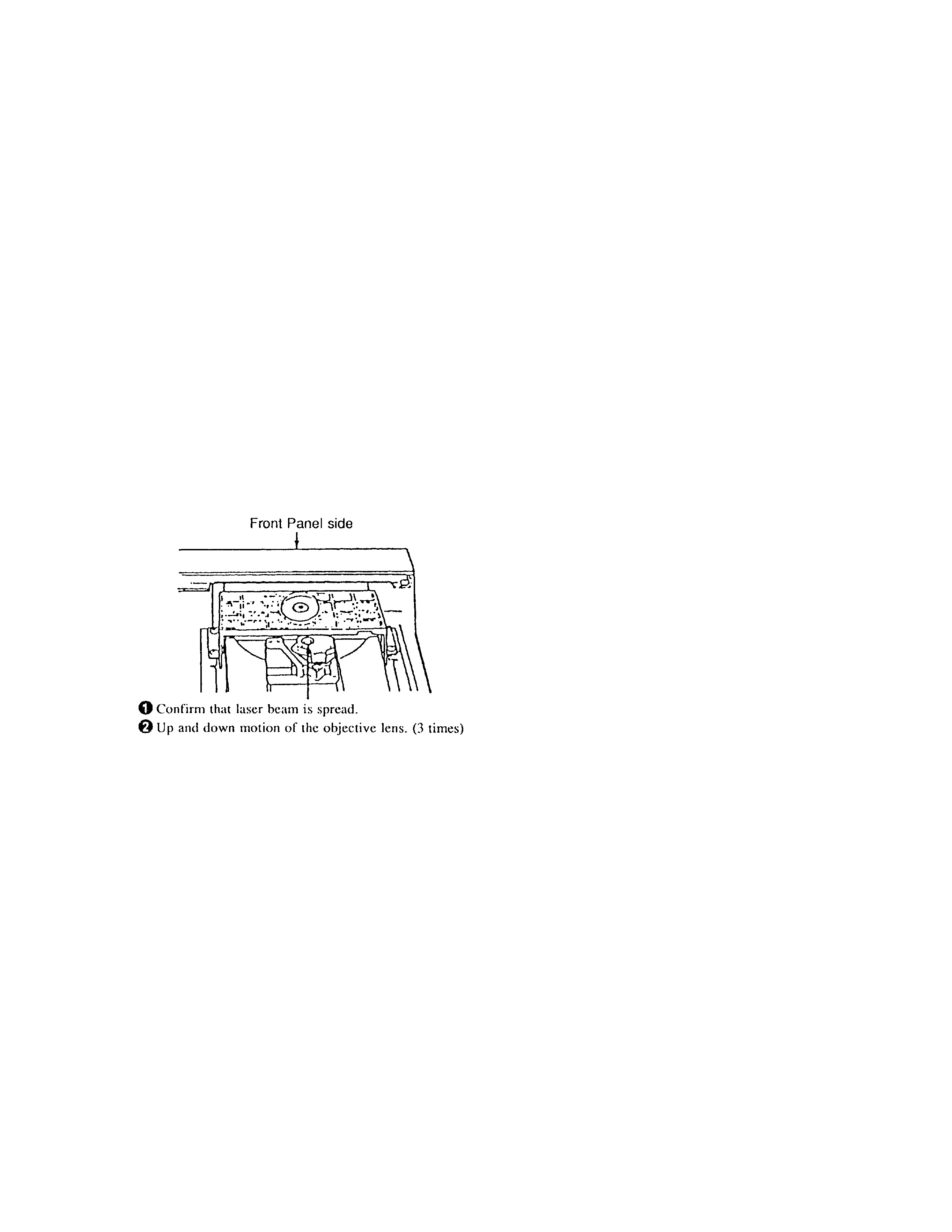
3
ATTENTION AU COMPOSANT AYANT RAPPORT
À LA SÉCURITÉ!!
LES COMPOSANTS IDENTIFIÉS PAR UNE MARQUE
! SUR LES
DIAGRAMMES SCHÉMATIQUES ET LA LISTE DES PIÈCES SONT
CRITIQUES POUR LA SÉCURITÉ DE FONCTIONNEMENT. NE
REMPLACER CES COMPOSANTS QUE PAR DES PIÈCES SONY
DONT LES NUMÉROS SONT DONNÉS DANS CE MANUEL OU
DANS LES SUPPLÉMENTS PUBLIÉS PAR SONY.
NOTES ON HANDLING THE OPTICAL PICK-UP BLOCK OR
BASE UNIT
The laser diode in the optical pick-up block may suffer electrostatic
breakdown because of the potential difference generated by the
charged electrostatic load, etc. on clothing and the human body.
During repair, pay attention to electrostatic breakdown and also use
the procedure in the printed matter which is included in the repair
parts.
The flexible board is easily damaged and should be handled with
care.
NOTES ON LASER DIODE EMISSION CHECK
The laser beam on this model is concentrated so as to be focused on
the disc reflective surface by the objective lens in the optical pick-up
block. Therefore, when checking the laser diode emission, observe
from more than 30 cm away from the objective lens.
LASER DIODE AND FOCUS SEARCH OPERATION CHECK
1. Make POWER switch on with no disc inserted and disc table
closed.
2. Confirm that the following operation is performed while
observing the objective lens.
SAFETY-RELATED COMPONENT WARNING!!
COMPONENTS IDENTIFIED BY MARK
! OR DOTTED LINE
WITH MARK
! ON THE SCHEMATIC DIAGRAMS AND IN THE
PARTS LIST ARE CRITICAL TO SAFE OPERATION. REPLACE
THESE COMPONENTS WITH SONY PARTS WHOSE PART
NUMBERS APPEAR AS SHOWN IN THIS MANUAL OR IN
SUPPLEMENTS PUBLISHED BY SONY.
TABLE OF CONTENTS
1. GENERAL
Identifying the Parts .................................................................. 4
Playing a CD .............................................................................. 5
2. DISASSEMBLY
2-1. Front Panel .............................................................................. 6
2-2. Base Unit Block ...................................................................... 6
3. ELECTRICAL BLOCK CHECKING ............................. 7
4. DIAGRAMS
4-1. IC Pin Functions ...................................................................... 9
4-2. Printed Wiring Board BD Section ................................... 13
4-3. Schematic Diagram BD Section ...................................... 15
4-4. Printed Wiring Boards Main Section .............................. 17
4-5. Schematic Diagram Main Section ................................... 19
5. EXPLODED VIEWS
5-1. Case Section .......................................................................... 26
5-2. Back Panel Section ................................................................ 27
5-3. CD Mechanism Section ......................................................... 28
5-4. Base Unit Section .................................................................. 29
6. ELECTRICAL PARTS LIST .......................................... 30
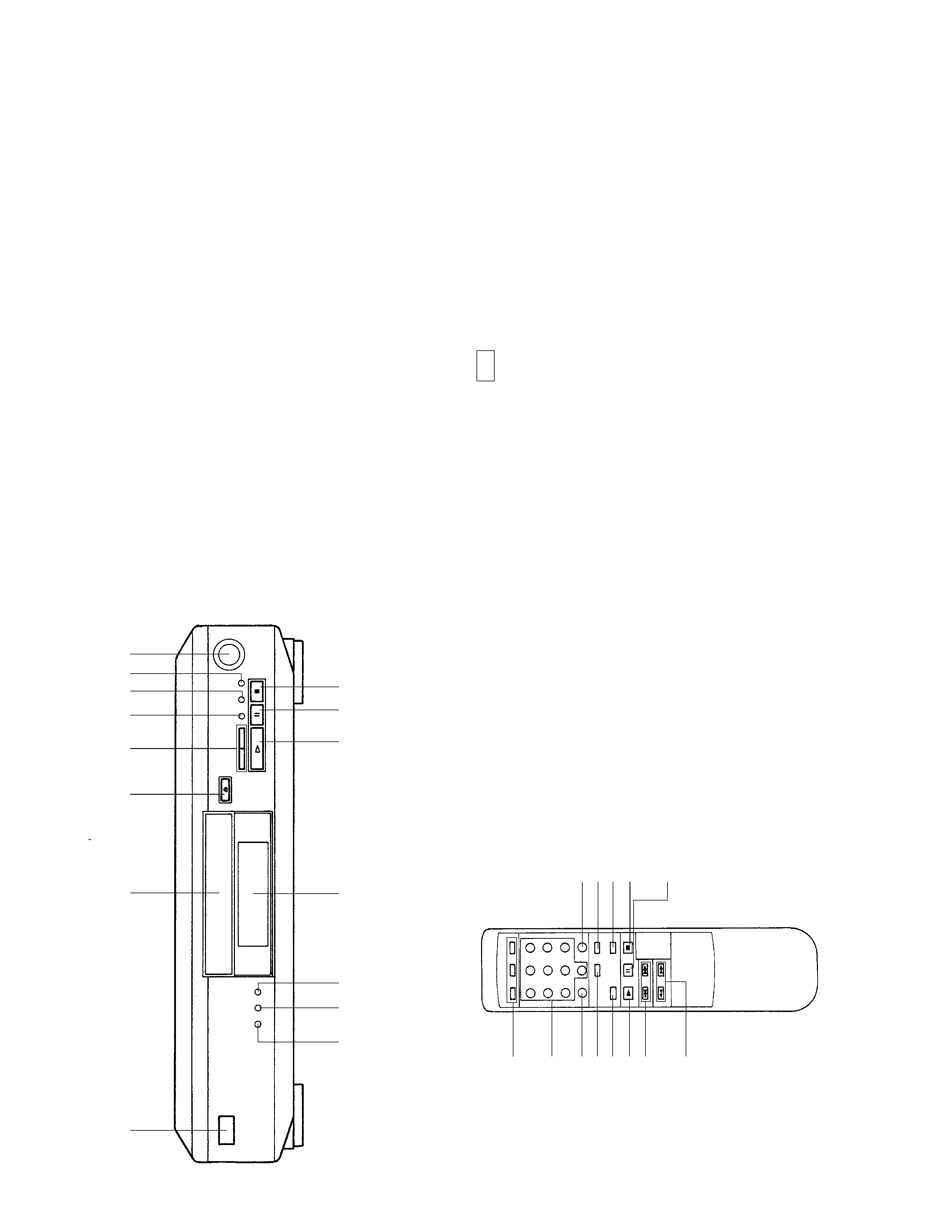
4
SECTION 1
GENERAL
IDENTIFYING
THE
P
A
R
T
S
RM-D420
(CDP-XE300
only)
Fr
ont
P
anel/Remote
Commander
1
PO
WER
s
witch
2
Disc
tr
a
y
3
§
OPEN/CLOSE
b
utton
4
0
/)
(man
ual
search)
b
utton
5
CHECK
(prog
ram
chec
k)
b
utton
6
CLEAR
(prog
ram
clear)
b
utton
7
ENTER
b
utton
8
AMS
±
(AMS
*
)control
9
p
(Stop)
b
utton
0
P
(P
ause)
b
utton
!¡
·
(Pla
y)
b
utton
!TM
Displa
y
!£
TIME
b
utton
!¢
REPEA
T
b
utton
!
PLA
Y
MODE
b
utton
!§
Pla
y
Mode
b
uttons
CONTINUE
b
utton
SHUFFLE
b
utton
PR
OGRAM
b
utton
!¶
Numer
ic
b
uttons
!·
>10
(o
v
er
10)
b
utton
!ª
TIME
b
utton
@º
=
/+
(AMS
*
)b
utton
@¡
F
ADER
b
utton
*
AMS
is
the
ab
bre
viation
of
A
utomatic
Music
Sensor
.
·
·
·
·
·
·
·
··
·
·
·
·
·
12
3
4
5
6
78
!
!¢
!£
!TM
!¡
0
9
·
·
··
·
·
··
·
!§
!¶
!·
!ª
!¢
!¡
@º
4
6
5
@¡
9
0
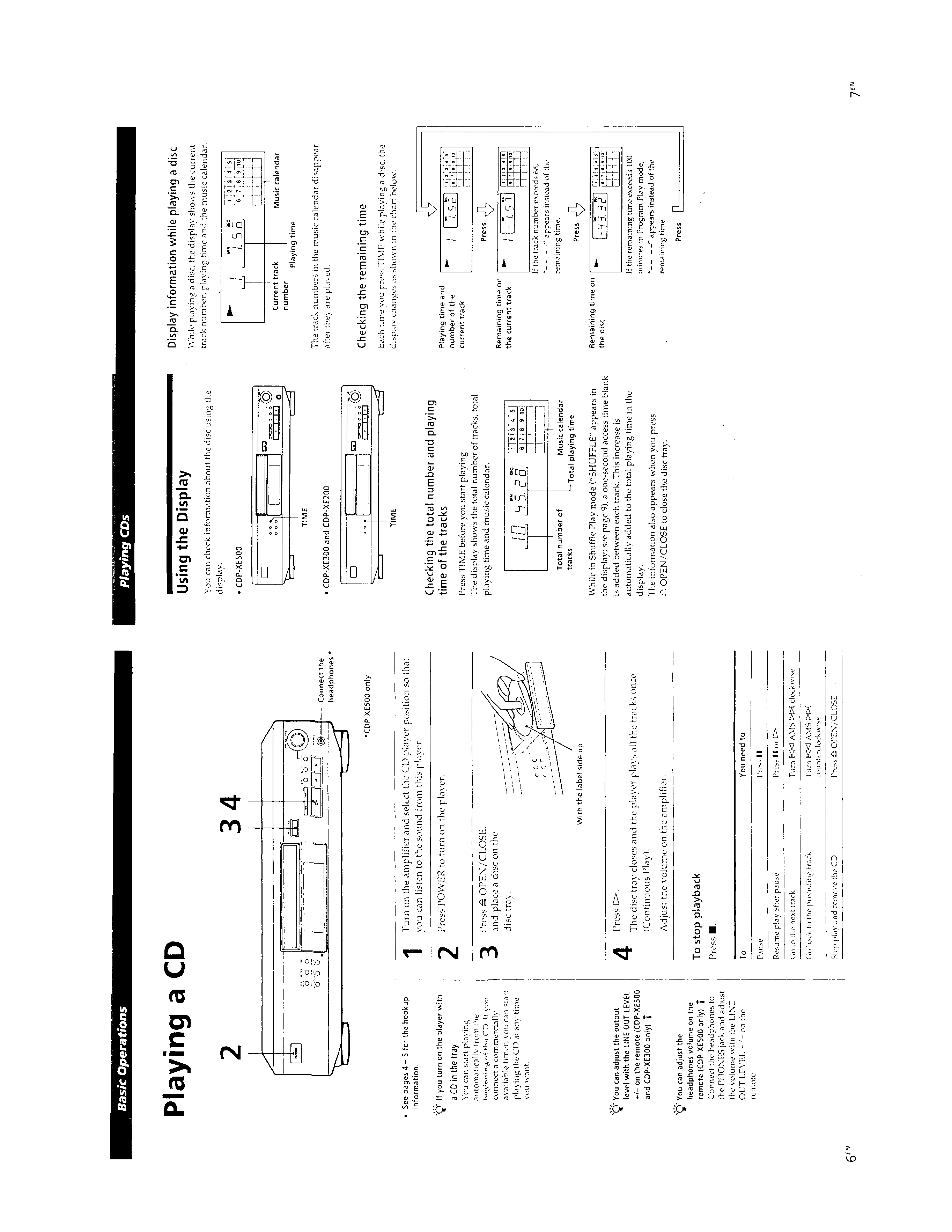
5
